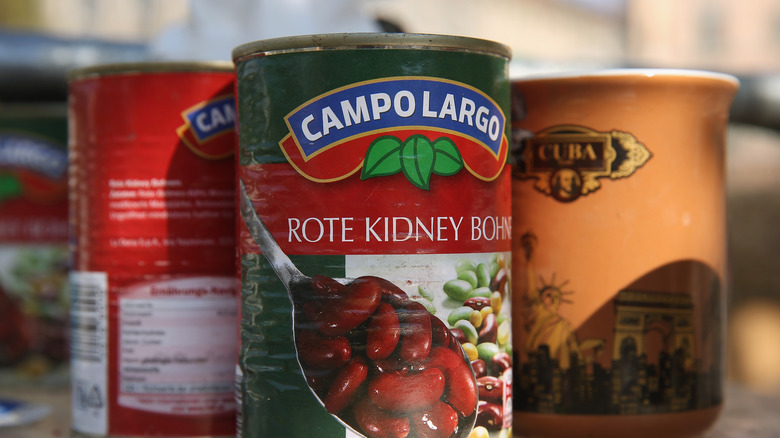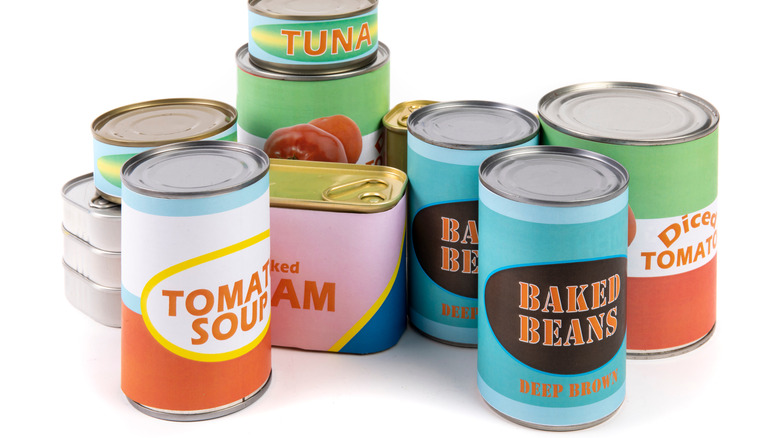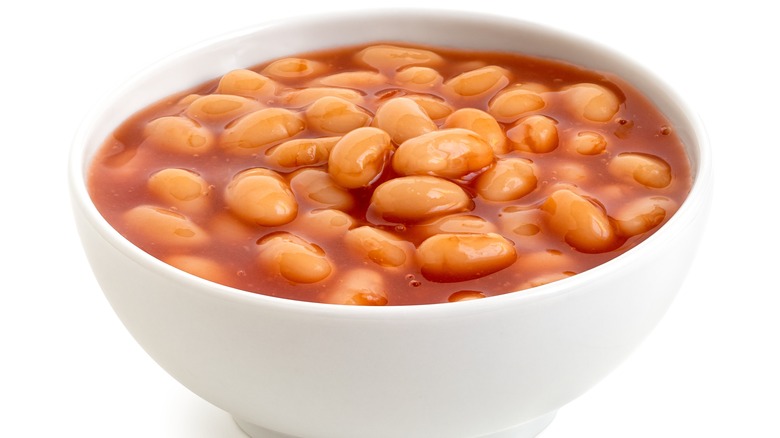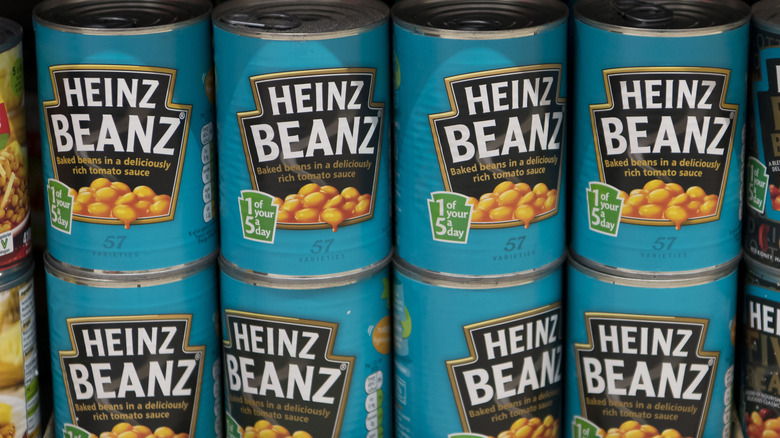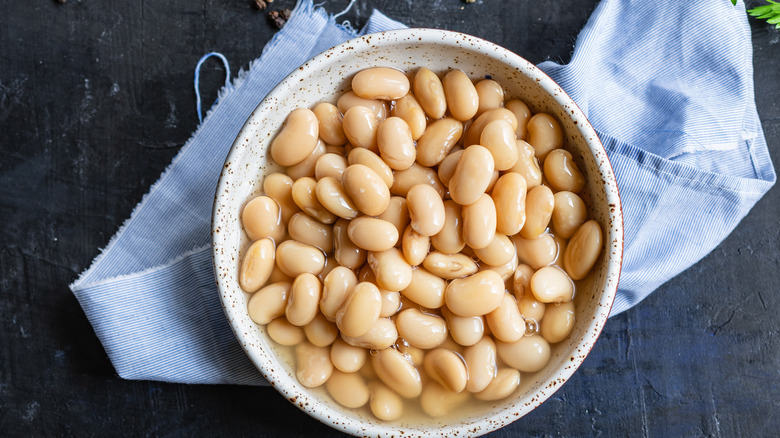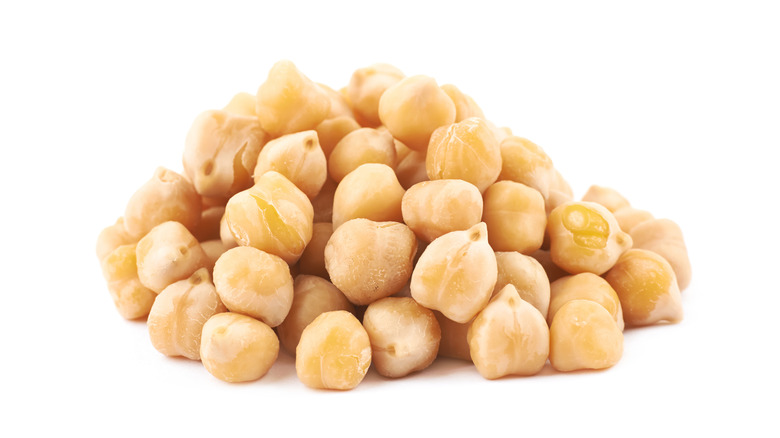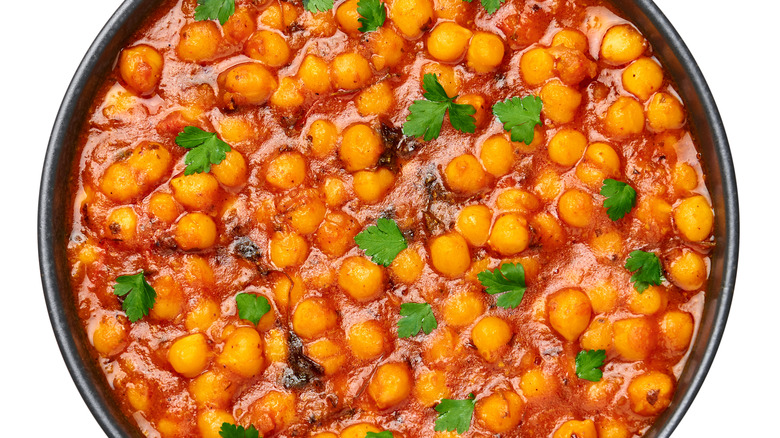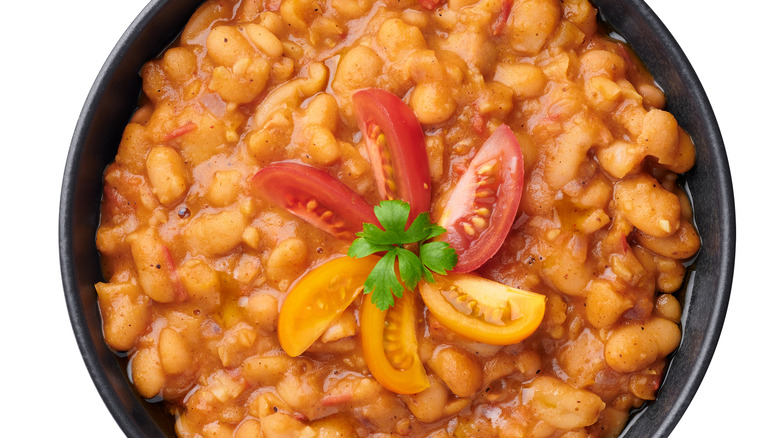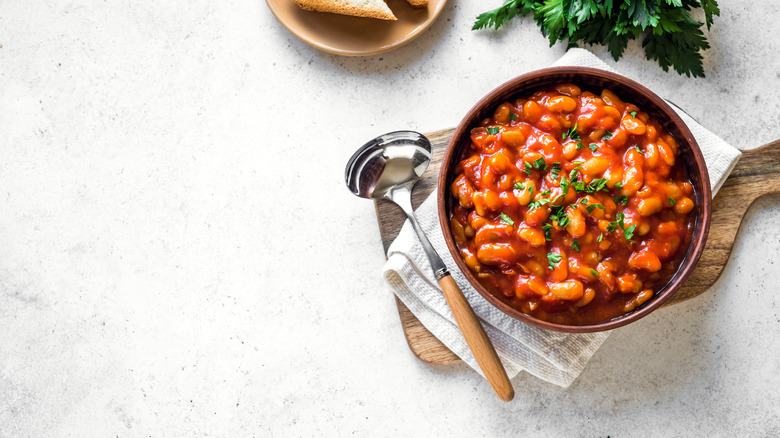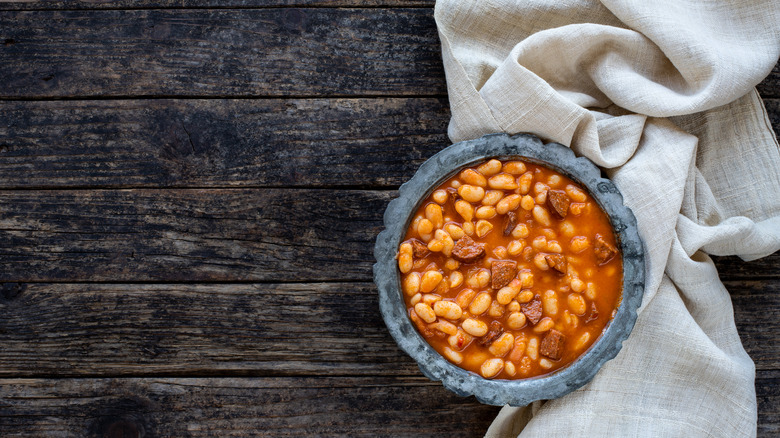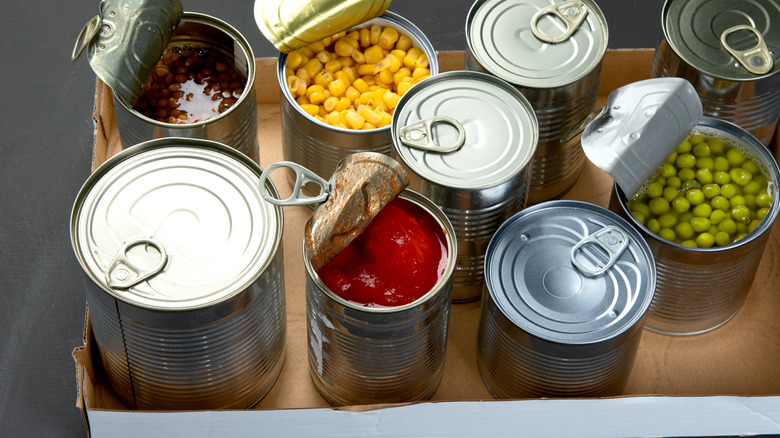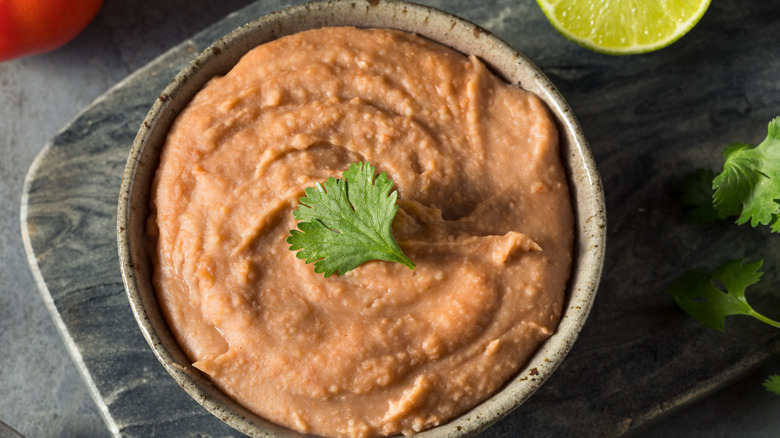The Biggest Myths About Canned Beans
Ever since the first canned beans appeared in the 1860s, they've become a reliable pantry staple. Shelf-stable and long-lasting, they've become a go-to solution for busy cooks who need to get a nutritious meal on the table fast, as well as a dependable and affordable source of protein for vegetarians or frugal omnivores looking to stretch their meat budget further (snobs who turn up their noses at beans in chili really need to get over themselves).
But like a dependable, low-maintenance friend, canned beans often get taken for granted. If they have a reputation at all, it's for being even lower on the glamor scale than their dried counterparts. And, like canned foods in general, per SuperKids Nutrition, they often get a bad rap for being compromised versions of their fresh counterparts. But don't worry — you don't have to feel guilty about buying and cooking with canned beans. We can't pretend they can always go head-to-head with the best home-cooked dried beans, but you can feel free to ignore the many myths and misconceptions about their quality and safety.
Canned beans are less nutritious than dried
A common misconception about canned beans is that they've been so heavily processed that all their nutrients have been leached out. And it's easy to see why one could think this: For most of us, the industrial canning process is somewhat mysterious and easy to imagine any number of sinister, invasive things that can happen to a bunch of beans between the time they're plucked from the vine and time they land in the canned food aisle.
But, in reality, canned beans undergo much less processing and time-related degradation than you might think. While fresh beans start losing their vitamin and mineral content as soon as they're picked, according to the Quad-City Times, canned beans (and other vegetables) are often processed the day they're harvested, which stops the natural degradation process and locks in the original nutrients. This means a can of beans that's been sitting on the grocery shelf for a few weeks is likely to have more nutrients than fresh beans that have been sitting around for a couple of days.
All canned beans are alike
Canned beans are such a low-profile, unglamorous foodstuff that it's easy to assume they're all pretty much interchangeable, apart from cosmetic differences such as size and color. But a closer look — and taste — reveals the world of canned beans is much more nuanced, and not all canned beans are created equal. Some bean types — including cannellini beans and garbanzos – maintain more of their inherent flavor and texture after canning than others.
In addition, SFGate notes that different brands of the same canned bean can vary greatly in flavor and quality. In a comparative taste test of eight brands of small, white cannellini beans (drained, but not heated), tasters found a wide range of tastes (from earthy to smoky to chemical-y) and textures (from perfect to mushy to nearly raw). The taste panel's runaway favorite brand was from Whole Foods Market, while of the eight brands tried, three rated so poorly they couldn't be ranked.
Canned beans are nothing but carb-heavy junk calories
Canned beans — and beans in general — have been getting a bad rap in the wellness and diet scene in recent years. Per the College of Health and Human Sciences at Colorado State University, several trendy diets, including Whole 30, paleo, and low-carb diets, have declared all beans a no-no. Why? Some have argued that beans are high in carbohydrates, which should always be avoided. In addition, others have said, beans are hard to digest and contain lectins, a type of protein that can cause inflammation.
But according to nutritionists at Colorado State University, these dangers are greatly exaggerated. In reality, the human body needs carbohydrates, and fiber-rich complex carbohydrates — such as those found in beans — are the best type for promoting steady energy levels throughout the day. And while lectins do occur in raw or undercooked beans (as well as other foods), the problem goes away completely with canned beans, which are fully cooked. Finally, while beans have a reputation for giving some eaters gas, in reality, most people enjoy them with no issues.
Cooked dried beans will always taste fresher than canned
There's no debate that a pot of freshly cooked, carefully seasoned, high-quality dried beans will always have an edge flavor-wise over its canned counterpart. However, this doesn't mean dried beans will always be fresher and better-tasting than canned: It is indeed possible to spend days presoaking, then simmering, a pot of dried beans and still ending up with a dud of a meal.
And if this happens to you, chances are it's because your beans are too old: While dried beans are durable, they're not immortal. Per Does It Go Bad, dried beans are best in the first year after production, but by their third birthday, they become tough and stay tough. And because dried beans can linger unsold on store shelves for months or years, there's often no telling how old they are when they get to you. So if you have the choice between cooking up that dusty bag of dried beans you've never gotten around to using or opening a can you got last week, go for the can — and repurpose your dried beans as pie weights.
Canned beans are always an inferior choice to dried beans
Fans of dried beans can wax rhapsodic about the many advantages of dried beans over canned beans — the hundreds of heirloom varieties available (versus the small handful of standard types available in cans), their superior flavor and texture, their lower cost (dried pinto beans are 15 cents a serving versus 35 cents a serving for canned pintos, per the Bean Institute) and, of course, the flavorful broth that comes as a side benefit of simmering your own beans.
All this may be true — but canned beans have one huge advantage: They can be ready to eat in mere minutes, if not seconds. Dried beans, on the other hand, must be cleaned, soaked overnight, then simmered for hours before being ready to eat. So no matter how skilled a cook you are, you can't just whip up a pot of them after a long day of work. And, if you choose your canned beans wisely and season them with care, you won't be compromising on flavor: Per SFGate, some canned beans are surprisingly flavorful.
Canned beans are dangerously high in sodium
Another common argument against canned beans is that they contain unhealthy amounts of sodium. And there's a grain of truth in this: Most varieties of canned beans (and canned veggies in general) contain added salt, per SuperKids Nutrition, while their fresh counterparts do not. However, as the Quad-City Times notes, canned beans still offer enough nutritional benefits, such as protein and cholesterol-lowering soluble fiber, to make them worth your while. And if you're going to cook dried beans yourself, you're almost sure to be adding salt to your final preparation — so the difference in sodium levels may not be as big a deal as portrayed.
But if you have reason to be extra careful with your sodium intake, you can still enjoy canned beans safely. Per SuperKids Nutrition, you can opt for salt-free or low-sodium brands. And if none are available in your area, simply rinsing your canned beans before using them can reduce their sodium content by up to 40%.
Canned beans aways have a mushy texture
Serious bean connoisseurs and cooks prefer dry beans over canned because they offer more control over the beans' final texture — per Huffington Post, an attentive cook can choose to cook them so they still hold their shape and have a bit of a bite or until they're soft and creamy, depending on the final dish or the cook's personal preference. With canned beans, on the other hand, you get what you get — and it might be unpleasantly mushy.
But with a little research and effort, you can take some control over the texture of the canned beans in your meal. As SFGate notes, some brands of beans have better textures and flavors than others, so seek out brands with a taste profile you think you'll enjoy. And creative cooks have developed hacks to enhance the flavor and texture of canned beans. Epicurious, for instance, recommends simmering canned beans in good-quality olive oil to improve their flavor and texture. And if they're still too mushy for your taste? Lean into the mush and make a batch of bean dip.
Canned beans are loaded with additives
Another common myth about canned beans is that they're loaded with additives — after all, what else would enable a bunch of beans to stay unchanged in a can for months, if not years? But in reality, the beans in your can may be closer to their original form than you think. Per Mealtime.org, canning is basically a sterilization process in which fresh beans or other vegetables are cleaned, cut (if needed), then heated under pressure in sealed, airtight cans to cook the food and kill any bacteria or other harmful organisms.
In short, the canning process, when done correctly, produces a sterile environment that preserves the cans' content without the need for preservatives. That being said, however, some brands of canned beans do include nitrates and /or nitrites as preservatives, according to Healthline. Healthline also notes that these additives are safe in small quantities. So if avoiding preservatives and other additives is a priority for you, check the labels on canned beans before buying.
The best way to reheat canned beans is on the stove
What's the best way to turn a simple can of beans into a compelling meal? Chances are, part of your process is opening the can, pouring its contents into a saucepan, and heating it on your stove — and, of course, generations of cooks have done this and had great results. But if you want to mix up your canned bean routine and refresh your weeknight dinner repertoire, try turning on your oven instead.
If you have a can of chickpeas (a.k.a. garbanzo beans) around, instead of turning them into a stew, you can make them into crispy roasted chickpeas, as recommended by Rainbow Plant Life. Toss drained, dried canned chickpeas in olive oil, salt, and the spices of your choice, scatter them over a sheet pan, and roast over medium-high heat until crispy. Rainbow Plant Life recommends roasting them alongside other veggies, such as sweet potatoes and broccoli, for an easy sheet pan dinner. And if you have a can of baked beans, Feast and Farm suggest you can make them taste more like homemade by mixing them with extra ketchup, mustard, and/or barbecue sauce and topping them with bacon slices before baking them uncovered until the sauces bubble and thicken.
Canned beans only come in cans
When shopping for ready-to-eat, shelf-stable beans, the first thing most shoppers will look for is an aisle full of cans. But not all canned beans come in cans: As The Prairie Homestead notes, home cooks have a long tradition of canning beans in jars. In this process, dried beans are cleaned, soaked, and partially cooked before being ladled into clean glass jars and heated and sterilized in a pressure canner. If you're into home canning and want to try this, The Prairie Homestead emphasizes that the more-common hot-water-bath sterilizing method will not do here; low-acid foods such as beans require pressure sterilization to ensure their safety.
And it's not just hardcore home cooks who can beans in jars. Some commercial brands of cooked beans also come in glass jars. But if the idea of seeing cooked beans in a jar seems strange to you, you might want to give them a chance: In SFGate's taste test of eight canned bean brands, the top two picks both came in jars.
Canned refried beans are always tasteless
There are some prepared foods we'd happily eat straight from the jar or can — peanut butter, Nutella, and on busy weeknights, a can of rinsed whole beans or tuna added straight into a salad. But there are others that we keep around for convenience, even though they're nobody's favorite. One of these is canned refried beans. While useful as a filler for a quick quesadilla, they're not something you'd typically be proud to serve to guests (except maybe in a seven-layer dip).
But a closer look reveals that not all canned refried beans are the bland-but-filling paste we've all encountered at some point. In its ranked review of canned refried beans, The Mercury News set some high standards, noting that the best canned refried beans, like the best restaurant beans, should be slightly chunky, rather than homogenous in texture. They should also be well seasoned and can even be spicy, but ideally, the seasonings shouldn't obscure the flavor of the beans. And what were the publication's picks based on those criteria? Surprisingly, they found Taco Bell Original Refried Beans came closest to tasting like homemade, and 365 Organic Refried Pinto Beans with Roasted Chili and Lime came in a close second.
